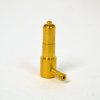68ragtop
Well-Known Member
Have any of you guys replaced check valves on a 951?
When I tested the check valves at teardown, they seemed to be functioning as they should. They held vacuum & also a little bit of pressure before releasing. at the time they might have had some residual oil in them that caused them to hold a little better.
The engine is together, painted & I was putting on some of the accessories. When I installed the oil injection lines I found that one of the check valves leaks slowly under any amount of pressure or vacuum. While I know these are not normally problematic, I don't want to put this engine in & find the crankcase filling with excess oil over winter.
So, I can order new check valves, but how hard are they to pull out of the case? I have never removed one. It would have been stupid easy when everything was apart, but I didn't see any reason to remove them at that time.
Thoughts?
When I tested the check valves at teardown, they seemed to be functioning as they should. They held vacuum & also a little bit of pressure before releasing. at the time they might have had some residual oil in them that caused them to hold a little better.
The engine is together, painted & I was putting on some of the accessories. When I installed the oil injection lines I found that one of the check valves leaks slowly under any amount of pressure or vacuum. While I know these are not normally problematic, I don't want to put this engine in & find the crankcase filling with excess oil over winter.
So, I can order new check valves, but how hard are they to pull out of the case? I have never removed one. It would have been stupid easy when everything was apart, but I didn't see any reason to remove them at that time.
Thoughts?













